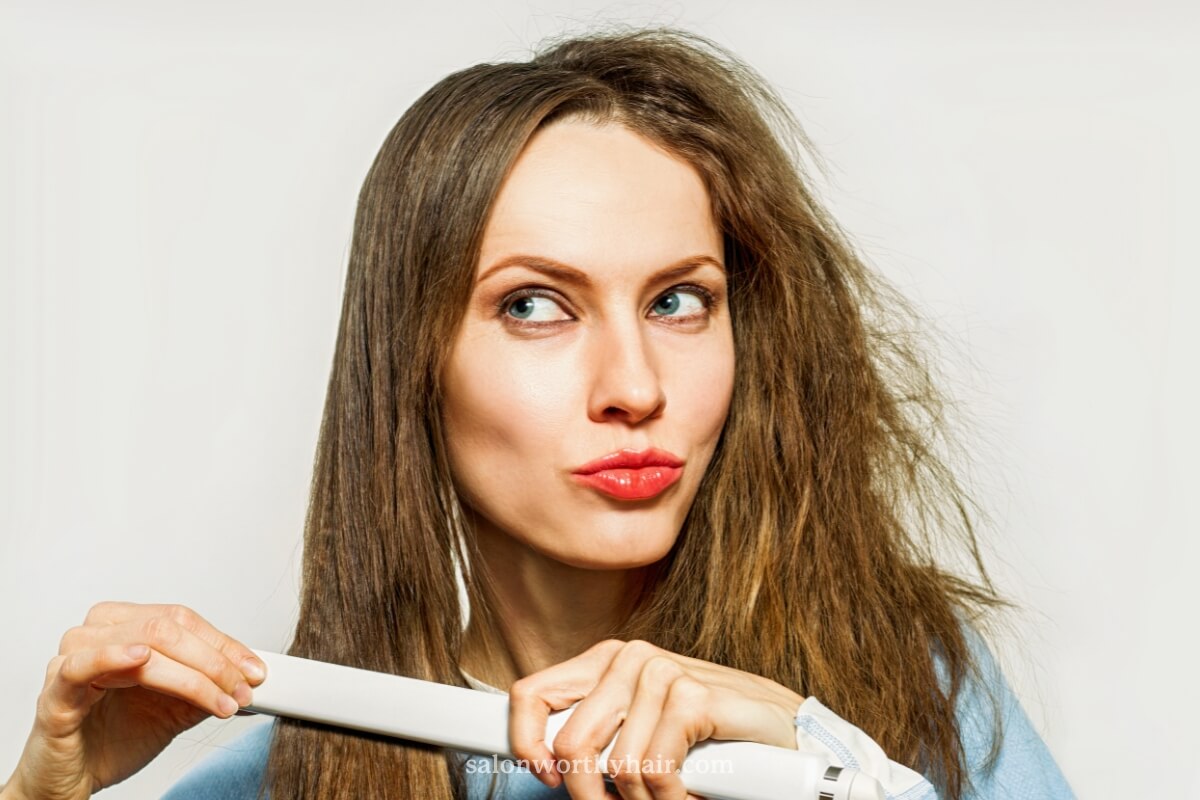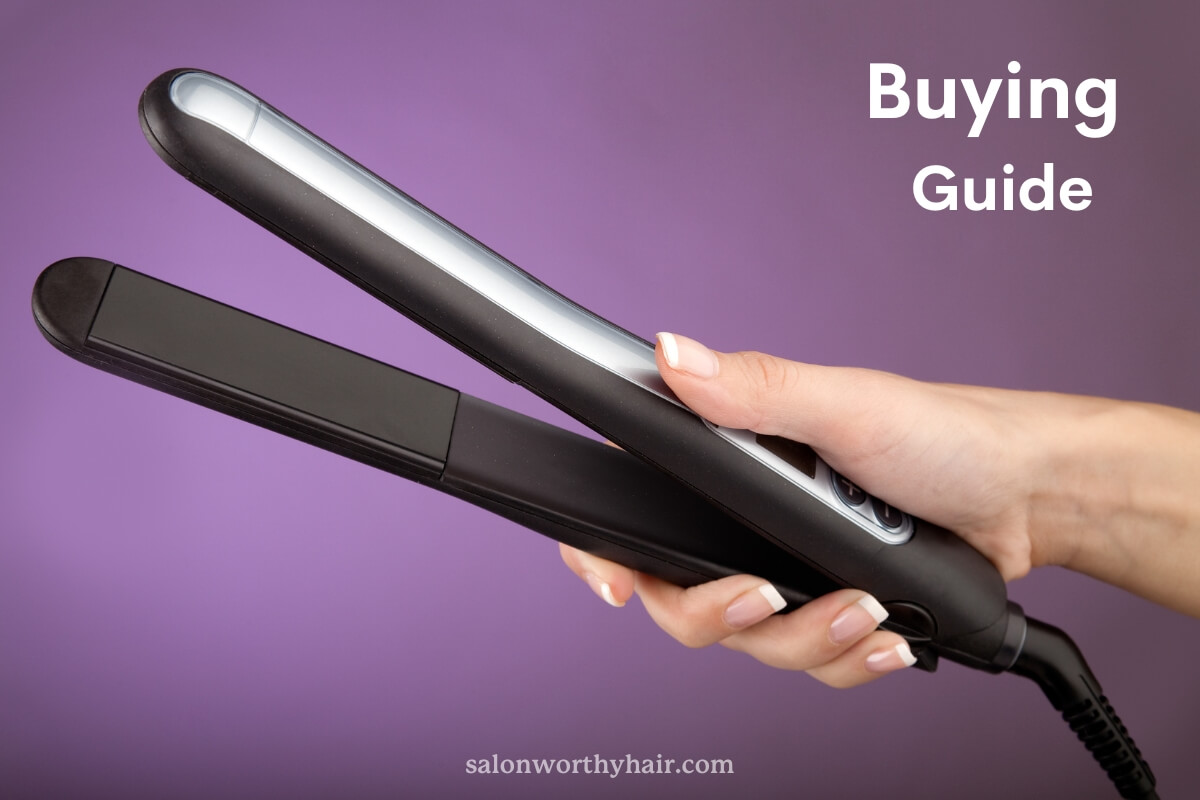10 Best Hair Straighteners Tested for Every Hair Type
Updated on
This post may contain affiliate links. As an Amazon Associate, we may earn from qualifying purchases.

A hair straightener is an indispensable hairstyling tool that makes your hair straight and smooth in minutes.
However, finding the ideal hair straightener requires careful consideration of various factors.
From ceramic to tourmaline plates, temperature range, dual-voltage, travel-friendly considerations, and hair type compatibility can make picking one confusing.
At Salon Worthy Hair, we tested and evaluated hair straighteners for various hair types at various temperatures – literally cranking up the heat!
Based on our extensive testing, we’ve hand-picked the best hair straighteners to make achieving your hair goals easier with minimal fuss.
Hair Straightener Buying Guide

Here is a checklist to guide you through the process of selecting the right hair straightener for your hair type and styling needs:
Determine Your Hair Type and Condition
| Hair Type | Straightener Selection |
|---|---|
| Fine or Thin Hair | Look for straighteners with adjustable temperature settings. Lower heat is sufficient and safer. |
| Thick, Coarse, or Curly Hair | Choose a straightener with higher temperature options and robust plate materials like titanium. |
| Damaged or Chemically Treated Hair | Opt for straighteners with ionic technology and materials that distribute heat evenly, such as ceramic or tourmaline. |
Consider Plate Material
| Plate Type | Hair Type |
|---|---|
| Ceramic Plates | Great for even heat distribution and less damage. Ideal for fine to normal hair. |
| Titanium Plates | Heat up quickly and maintain high temperatures. Suited for thick, coarse hair. |
| Tourmaline Plates | Emit negative ions to reduce frizz and enhance shine. Beneficial for damaged or frizzy hair. |
Temperature Control Settings
A variable temperature setting in a hair straightener can be useful for hair types and textures that require different heat levels to achieve the desired styling results. Applying too much heat can cause damage, while not enough heat may not be effective in straightening the hair.
Here’s a table that summarizes the recommended temperature range for different hair types:
| Hair Type | Heat Range (°F) | Notes |
|---|---|---|
| Fine, Thin Hair | 300-350°F | Fine, thin hair is more delicate and can easily be damaged, so it’s best to use a lower heat setting. |
| Normal Hair | 350-400°F | Normal hair is generally healthy and can handle moderate heat. |
| Thick, Coarse Hair | 400-450°F | Thick, coarse hair requires the maximum temperature to straighten effectively. |
| Curly Hair | 300-400°F | Curly hair is often more delicate and prone to frizz, so it’s best to use a lower heat setting to avoid damage and enhance the natural curl pattern. |
Please note that these are general guidelines and that individual factors, such as the hair’s condition, may also impact the appropriate temperature setting. It’s always best to start with a lower temperature setting and gradually increase it as needed.
Size and Shape of the Straightener
- Narrow Plates: Narrow straightener plates are etter for short hair or detailed styling like bangs.
- Wide Plates: Wide plates are ideal for long, thick hair as they cover more area.
Additional Features
- Wet-to-Dry Technology: For those who prefer to style damp hair.
- Ionic Technology: To combat frizz and static, especially in humid conditions.
- Smart Features: For customized heat settings and added convenience.
Safety Features
- Auto Shut-off: A crucial feature for safety, especially if you often forget to turn off your appliances.
- Long Swivel Cord: For ease of use and flexibility.
- Heat-resistant Mat: Helps to protect the surface you are placing the straightener on from being damaged by heat from the device.
Durability
A hair straightener with good durability will last longer. It can save you money in the long run. A durable hair straightener is also less likely to break or malfunction. You can rely on it to perform consistently without damaging your hair.
Look for the quality of the materials used, the brand’s reputation, and customer reviews.
Ergonomics
Ergonomics means comfort, ease of use, reduced risk of injury, and less styling time.
When looking for a new hair straightener, consider factors such as the shape and design of the tool, the weight distribution, and the grip. A hair straightener with good ergonomics will be easier to handle, making it easier to style your hair without frustration.
Dual Voltage
A hair straightener with dual voltage means the tool can be used internationally without needing a voltage converter. This is particularly important for people who travel frequently or plan to use their hair straightener in different countries.
Some hair straighteners are designed to work with a specific voltage, which may differ from other countries’ electrical outlets. If a hair straightener is not dual-voltage, it may not work or can get damaged when used in a country with a different voltage.
Travel-Friendly
A hair straightener can be considered travel-friendly if it’s compact, lightweight, has dual voltage, and has a heat-resistant protective pouch or case.
When buying a new travel hair straightener, you should look for the following features:
- Size and weight: Choose a compact, lightweight model that fits your luggage easily.
- Dual voltage: A hair straightener with dual voltage is ideal for traveling as it can adjust to the local voltage, making it compatible with different electrical outlets worldwide.
- Protective pouch or case: A heat-resistant protective pouch or case can help keep the straightener safe while traveling and prevent it from being damaged in transit.
- Airplane mode: Most new hair straighteners with digital features have airplane mode to ensure the device is disengaged for safety during a flight.
Warranty
A warranty provides peace of mind and protection in case of any defects or issues with the product.
A warranty can vary in length and coverage. Still, it typically covers repair or replacement of the product if it stops working or malfunctions within a certain period. A warranty can save you money and inconvenience in the long run, as it can cover repairs or replacements that would otherwise have to be paid out of pocket. Additionally, a warranty is a sign of the manufacturer’s confidence in the quality of their product and their commitment to customer satisfaction.
Look for a product that offers a minimum of 2 years warranty.
Product Warranties may only be applicable when you buy the product directly from the manufacturer’s official website. Please check with the seller if you buy from Amazon, eBay, or Walmart.
Which Hair Straightener is Best for Your Hair Type?
Here’s a guide on how to pick the best hair straightener for different hair types:
| Hair Type | Straightener Type | Reason |
|---|---|---|
| Fine, Thin Hair | Ceramic or Tourmaline | These types of plates are gentle on fine, thin hair and provide even heat distribution to avoid damaging the hair. |
| Normal Hair | Ceramic or Tourmaline | Ceramic or tourmaline plates are suitable for normal hair as they provide even heat distribution, help reduce frizz, and make the hair shiny. |
| Thick, Coarse Hair | Titanium | Titanium flat irons heat up quickly and provide high heat, making them ideal for thick, coarse hair that needs extra heat to straighten. Go for large and wide plates that can grab more hair in one go. |
| Curly Hair | Ceramic or Tourmaline | These plates are best for curly hair as they help reduce frizz, maintain moisture, and enhance the natural curl pattern. |
| Frizzy Hair | Ionic | Ionic heat produces negative ions to neutralize positive ions that are present in the hair, causing frizz. Negative ions also smoothen the hair cuticles. |
How Do You Know If You Need a New Hair Straightener?
Here are the signs that indicate that it’s time to replace your current hair straightener:
- Heat inconsistency: If your hair straightener is no longer heating evenly, it may be time to replace it. Uneven heat distribution can result in patchy, uneven styling and make it difficult to achieve the desired results.
- Damaged plates: If the plates on your hair straightener are damaged, chipped, or warped, it’s time to replace your device. Damaged plates can cause hair to snag or pull, leading to damage and breakage.
- Poor performance: If your straightener is no longer straightening your hair effectively, it may be time to replace it. Various factors, such as worn-out heating elements or a decrease in the overall quality of the tool, can affect its performance.
- Safety concerns: If your hair straightener’s cord is frayed or the tool is overheating, it’s time to replace it. It will prevent accidents and protect your hair and scalp from damage.
- Increased repair costs: Replacing it may be more cost-effective if you find yourself constantly repairing your hair straightener. Over time, the cost of repairs can add up, making investing in a new, high-quality tool more economical.
Considering these signs and replacing your hair straightener is important to ensure you use a safe and effective styling tool. By investing in a high-quality hair straightener, you can achieve better styling results and protect your hair from damage.
Final Verdict
The GHD Platinum hair straightener comes out on top for its ease of use and state-of-the-art features that make it safe and ergonomic. The smart sensors on this hair straightener and the glossy plates make hairstyling a breeze, with guaranteed smooth and sleek hair without any kinks and frizz.
The Dyson Corrale is also highly recommended, but it is more expensive.
About the Author
 Charlene Latreuille
Charlene LatreuilleCharlene Latreuille has been blogging for over 10 years and has a background in digital marketing.
Specializing in women's hair health, she blends scientific insight with practical advice, crafting easy-to-follow guides.









